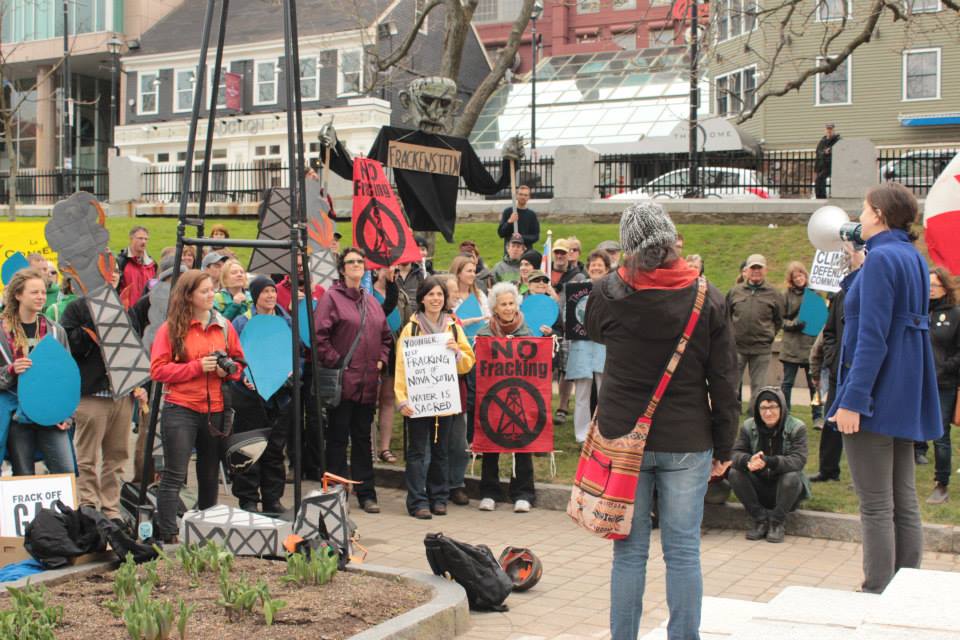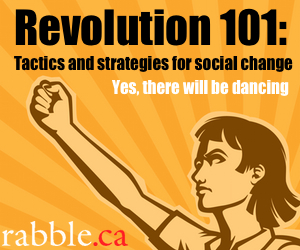While creativity and direct action have been used in social movements for ages, they’re just breaking into the climate movement in Atlantic Canada — with exciting and important lessons to be learned!
These are one woman’s reflections on a few recent actions that have taken place in Halifax, and a few lessons learned through those experiences.
The events
On March 31, the Nova Scotia Energy Minister, Andrew Younger, gave a speech at a breakfast event at the Westin Hotel in Halifax. Hosted by the Maritimes Energy Association, sponsored by Heritage Gas, and attended by dozens of industry representatives, the $70-a-plate briefing was billed as an opportunity for the Minister to speak about the province’s plan to move forward on oil and gas projects.
Before he could start his speech, Younger was interrupted by four women from Indigenous communities along the proposed route of the Energy East tar sands pipeline. Eliza Knockwood took the stage at the briefing, sang the Mi’kmaq honour song, and issued a notice of trespass to government and industry groups interested in fossil fuel extraction in Mi’kmaq’i. This intervention was met with hostility from the organizers of the briefing, one of whom tried to grab the drum out of Knockwood’s hands.

Eliza Knockwood and daughter deliver a notice of trespass to government and industry representatives, warning that they may not develop oil and gas reserves or build pipelines in Mi’kmaq’i. (Credit: Lindsay Hughes)
Meanwhile, 100 people rallied outside the hotel, following PowerShift Atlantic, to support Indigenous communities in rejecting the Energy East pipeline and fracking projects in Atlantic Canada.

Protesters rally outside the Westin Hotel to support Indigenous women in disrupting a government-industry meeting about fossil fuels in Atlantic Canada. (Credit: Robert Van Waarden)
On May 10, as part of the “Defend our Climate – Defend Our Communities” national day of action for climate justice, 80 people rallied in downtown Halifax to demand that the about-to-expire moratorium on fracking be extended indefinitely. After a short rally in Parade Square, teams split off to different locations in Halifax; one team went to the farmer’s market to leaflet about fracking, another stayed in Parade Square to continue leafleting, and another set up a fake fracking rig outside the office of Corridor Energy — the company trying to drill offshore in the Gulf of St. Lawrence and start fracking in New Brunswick.

Robin Tress and Annie Clair talk fracking at the May 10 Defend Our Climate – Defend Our Community rally in Halifax (Credit: Stephen Thomas)
On the same day in Wolfville, Fredericton, Charlottetown, and about 100 towns across Canada, thousands of people gathered for rallies calling out local injustices and calling for a better future.
These demonstrations were big accomplishments and learning moments for the climate justice movement in Atlantic Canada. The rest of this article will break down key elements of success of the actions and what we can learn from these experiences.
Specific target, demand and messaging
Every action or demonstration is a story, and all stories need characters, a conflict, a setting and a plotline.
When protesters stormed the Westin Hotel on March 31, we did it because conversations were happening between the Minister of Energy and fossil fuel industry reps, and they weren’t including the voices of impacted communities. We came to tell them that our voices will be heard, our communities will not be shattered by fossil fuel development, and they were not welcome to pursue fossil fuel development here.
This specificity was a huge strength of this action. The message came across very clearly to the targets — the government and industry reps at the breakfast — and it didn’t get muddled in the media.
This weekend when we rallied to continue the ban on fracking we had a specific demand, but a less specific target. While it was good to align with and support actions happening across the country as part of the national day of action, we had a less clear target for our own event. Identifying good targets and developing good messaging is a challenge, and ones whose roles shouldn’t be underestimated in crafting an action that pushes the movement forward.
Frontline communities at the forefront of the action
Effective actions that push the movement forward are directed by frontline communities and leaders. People and communities experiencing injustice must lead the conversation about how to solve the problem, and supporters who aren’t on the frontlines need to be ready to respect frontline needs.
On March 31 when four Indigenous women from along the Energy East route interrupted the government-industry breakfast meeting, at the moment that they took the stage inside the meeting, two banners dropped outside from the roof of the hotel, one with the message “Water is Sacred” — a common message that was being shared by the women inside the meeting. The 100+ protesters outside the hotel were mostly young, non-Indigenous people there to support those inside the meeting.

Protesters rally outside the Westin Hotel to support Indigenous women in disrupting a government-industry meeting about fossil fuels in Atlantic Canada. (Credit: Robert Van Waarden)
Speaking from the perspective of a settler cis-woman with a few years of experience in climate justice organizing, allyship is a difficult thing to conceptualize, much less do. But this action on March 31 was a great example of dozens of allied people and communities taking direction from people on the front lines of climate injustice and fossil fuel extraction and transportation.
To be very clear, I’m not saying that good allyship has never existed before in the Atlantic region. What I’m saying is that this action gave a new generation of climate justice activists and organizers a taste of what it means to be an ally and how to enact allyship.
Normalizing creative disruption and non-violent direct action for justice
In Atlantic Canada there are few actions that directly attack the fossil fuel industry and government’s responsibility for climate chaos that have happened outside of the frontlines of climate change and resource extraction. There have been countless physical blockades and resistance in the physical locations that extraction is happening or could happen, but there haven’t been many disruptions of business as usual with the expressed purpose of naming the names of power-holders enacting climate injustice.
Setting this type of precedent is a big step for the movement. Normalizing direct action is a big step for a movement to take, and an important one to keep the movement moving forward.
The March 31 disruption and May 10 rally showed that disrupting and rerouting processes that don’t include frontline and community voices, like $70-breakfast briefings with industry reps, and to directly name the people and systems enacting an injustice, is a really effective way of moving closer to our goals. This step is a huge challenge for many people and groups to overcome, as it starts to call into question entire systems of government and power. Getting a team or community to take this step is crucial to the success of the movement.
Police, risks, and scare tactics
Most of the people at the March 31 demo were new to creative action and confrontation. Most people had never been at an action where someone was arrested, and most of us had never taken over space in a private building.
When we entered the lobby of the hotel, one person was arrested. One rally leader announced that the police said they’d start arresting people who stayed in the hotel. Everyone cleared out pretty quickly. We were not prepared to risk arrest — that was not a decision we made prior to the action, and was not something we were willing to risk without deliberation.

Climate justice activists storm the Westin Hotel on March 31 to protest a meeting between government and fossil fuel industry representatives. (Credit: Robert Van Waarden)
The police arrested one man, drove him away from the hotel, and let him out three blocks away without a ticket or charges. It was a bluff.
Upon reflection, it could have been easy to stay in the hotel and hold the space, which would have lent more support to the four women inside the meeting. There were only four police officers, and almost 100 people. The crowd was not being violent and destructive — just loud and inconvenient. Had we discussed the possibility of arrest more seriously prior to the day, we could have reacted better to the police scare tactics of isolated and pointless arrests.
Having honest discussions during the planning of actions about the possibility and value of arrest, and having police liaisons trained to deal with and overcome police scare tactics like what we saw on March 31, is critical to any action.
Reframing the problem
A good action tells a story, and a good story has a moral or lesson. Activists can and should create a story that shows the lesson they’re trying to teach. In the cases of both of these actions, and many other events within the climate justice movement, the moral of the story was that climate change is not a fight against pollution, it’s a fight against polluters, and those polluters have names and addresses.
Robin Tress is an activist and the coordinator for Powershift Atlantic. Follow her @RobinTress



